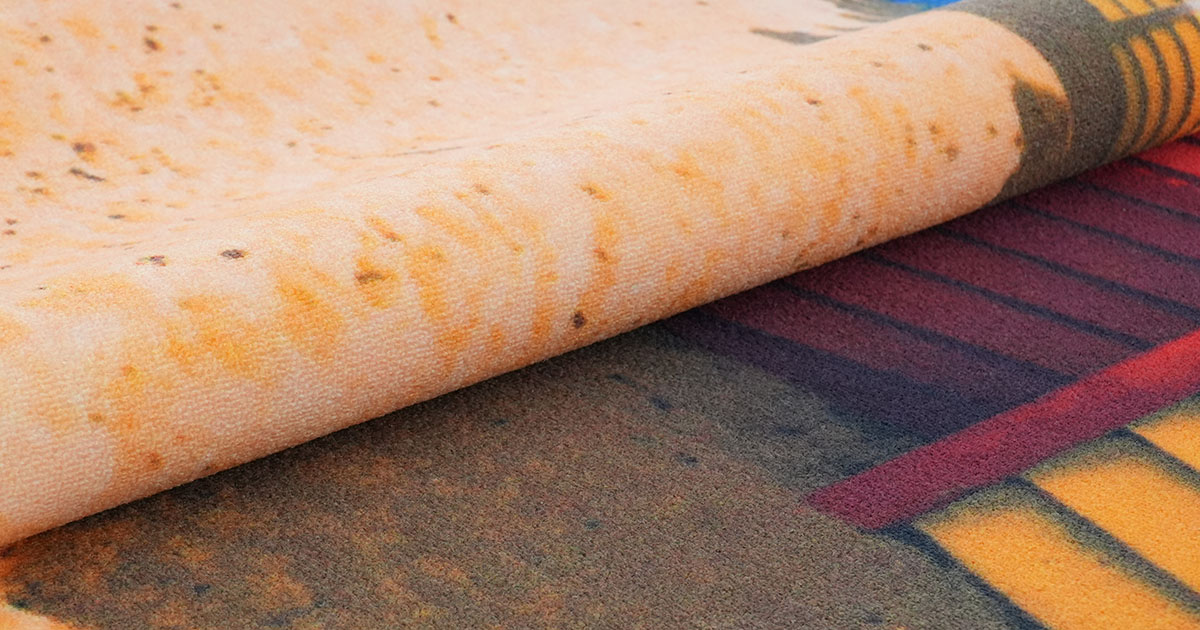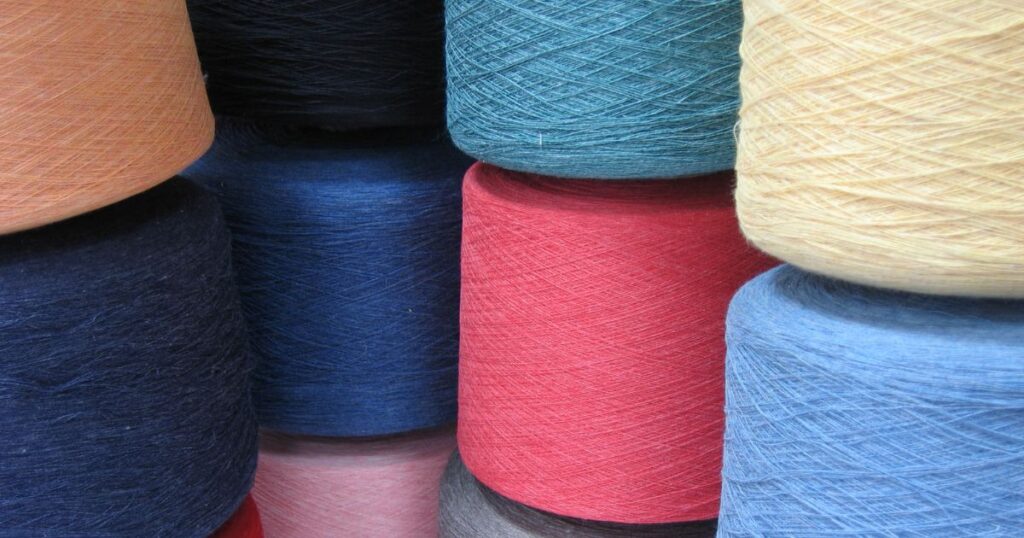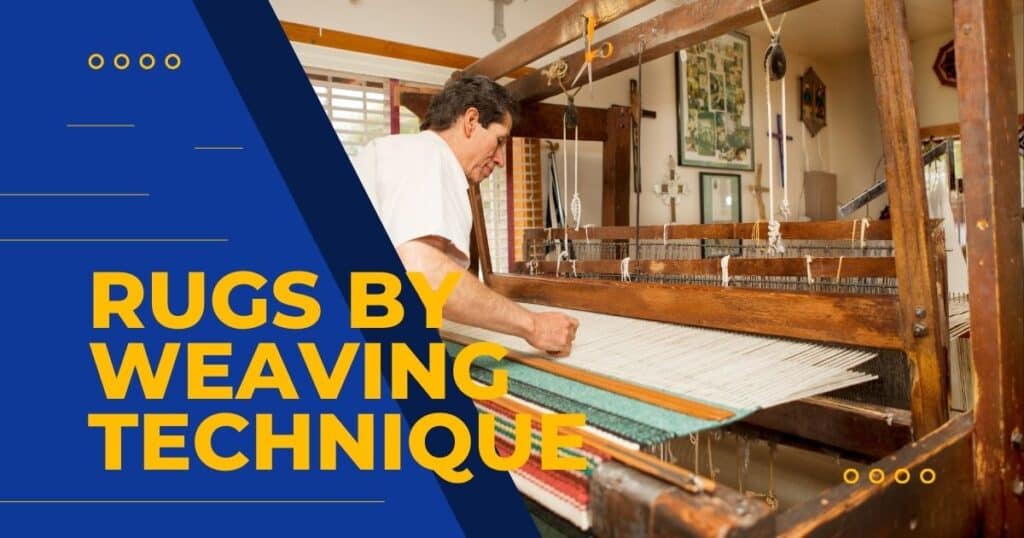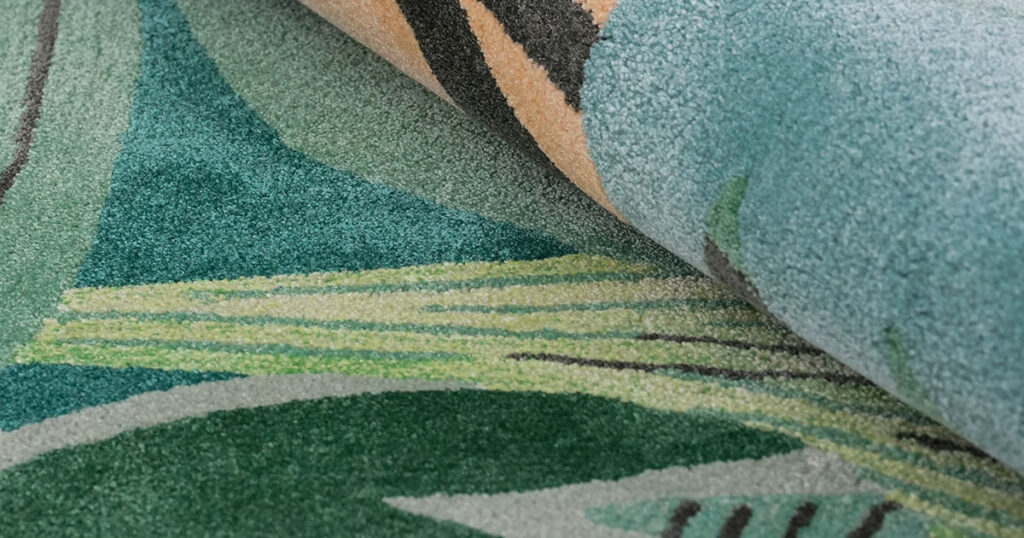Custom printed polyester rugs combine creative freedom with practical durability, turning ordinary flooring into a branding canvas or design statement.
This guide explores everything you need to know about printed polyester rugs – from material benefits to maintenance requirements – helping you make informed decisions for your retail store, hotel, office, or event space.
What Are Printed Polyester Rugs?
Custom printed polyester rugs are floor coverings made from polyester fibers where designs, patterns, or imagery are applied through high-resolution printing rather than traditional weaving or dyeing methods.
Unlike conventional rugs with limited color and pattern options, printed polyester rugs can showcase virtually any design – from photorealistic images to complex graphics with unlimited colors.
Why Printed Polyester Rugs
Design Freedom
The most compelling reason to choose printed polyester rugs is the unlimited design potential.
You can:
- Display your logo and branding elements
- Create custom patterns that complement your interior design
- Print photorealistic images or complex graphics
- Include informational elements or wayfinding
- Change designs seasonally or for special promotions
Cost-Effectiveness
Printed polyester rugs deliver significant value compared to alternatives:
- More affordable than custom woven or tufted rugs
- Design complexity doesn’t increase cost (unlimited colors at no extra charge)
- No setup costs for different patterns
- Quick production timeline for tight deadlines
- Easy and economical to replace when designs need updating
Practical Benefits
Beyond aesthetics and cost, printed polyester rugs offer several functional advantages:
- Stain resistance (polyester naturally repels liquids)
- Vibrant color retention
- Hypoallergenic properties
- Mold and mildew resistance
- Soft, comfortable underfoot feel
Why Polyester Works for Printed Rugs
Polyester’s specific properties make it ideal for printed commercial rugs:
Key Material Advantages
Color Vibrancy: Polyester accepts dyes and inks beautifully, producing rich, sharp designs with excellent color clarity.
Stain Resistance: The hydrophobic nature of polyester means it naturally repels liquids rather than absorbing them. This makes polyester rugs more resistant to water-based stains and quicker to dry after cleaning.
Cost-Efficiency: Polyester is one of the most affordable carpet fibers, generally less expensive than nylon of comparable quality.
Sustainability Options: Many polyester carpets today use recycled PET (the same plastic as water bottles), making them both affordable and increasingly eco-friendly.
Polyester Types Used in Rugs
The term “polyester” in rugs usually refers to PET (polyethylene terephthalate), including its recycled variants. Different constructions include:
Tufted Polyester: Yarn tufted into a backing to create a pile (cut or loop) with more cushioning and a traditional rug feel.
Needle-Punched Polyester (Felt): Fibers matted into a dense felt-like sheet creating a flat, velvety surface ideal for printing sharp images. Often used in trade show carpets.
Woven or Non-woven Polyester Fabric: Sometimes a polyester fabric (like canvas) serves as the printable surface, backed to create a rug.
Durability Considerations
A common question concerns polyester’s performance in high-traffic areas. While polyester has slightly lower resilience compared to nylon (meaning fibers may flatten sooner under heavy use), modern high-quality polyester rugs perform quite well in commercial settings.
Key durability factors include:
- Face weight and density: Heavier ounce weight and denser fiber packing wear better.
- Pile type: Many printed rugs use a very short pile or flat surface for better print clarity, which can actually help with durability in high-traffic zones.
- Backings and reinforcement: Quality backing materials support the rug and prevent stretching or deforming.
Printing Technologies
The magic of custom printed rugs happens through advanced digital textile printing.
Two primary methods are used.
Dye Sublimation Printing
This popular technique for polyester involves first printing artwork onto special transfer paper using sublimation inks. The paper is placed against the polyester rug and heated under pressure, causing the ink to transform into gas and bond directly into the polyester fibers.
Benefits of dye sublimation
- Extremely high-resolution, continuous-tone imagery
- Excellent color vibrancy and fidelity
- Permanent coloration that becomes part of the fiber itself
- Washable, scratch-resistant, and fade-resistant prints
- Ideal for small batches or one-off custom pieces
Direct Digital Printing
This approach prints directly onto the carpet surface using large-format inkjet printers or specialized carpet printing machines. The printed design is then fixed using heat or UV light.
Benefits of direct digital printing
- Works with various fiber types beyond just polyester
- Can print very large pieces or rolls in one go
- Handles complex designs and multiple colors
- Accommodates wider widths for seamless large area rugs
While both methods produce excellent results, dye sublimation is typically preferred for polyester rugs due to the exceptional durability of the print – the design literally becomes part of the fiber rather than sitting on top.
Design Considerations
When planning your custom printed rug, keep these design factors in mind:
Branding Opportunities
Printed rugs excel as brand assets, incorporating logos, taglines, and promotional graphics directly into your flooring. This reinforces brand identity in a subtle but omnipresent way. Consider using rugs for:
- Reception areas and entrances with your logo
- Trade show booths with promotional messaging
- Retail spaces with seasonal themes or product highlights
- Corporate spaces with mission statements or values
Color Matching and Consistency
Quality suppliers use color matching systems like Pantone to ensure printed colors match your brand standards. Provide Pantone or RGB/CMYK references for all key colors in your design.
Remember that colors can appear slightly different on textile versus on screen – another reason to request a sample proof before full production.
Practical Design Tips
Resolution and Scale: Design at 300 DPI for the final print size, but avoid very thin lines or tiny text in logos. Since rugs are viewed from above, designs should be bold and clear enough to read at a glance.
Color Considerations: Most printing can reproduce millions of colors, but extremely vivid neon or metallic colors may appear less bright or reflective than on screen.
Edge Awareness: Leave margins in critical design elements so nothing important gets cut off during binding or trimming.
Light Color Strategy: Large white or very light areas will show dirt more readily in high-traffic commercial spaces. Consider using light gray or beige backgrounds or adding subtle patterns to help hide soil.
Design Layout: Decide whether you want a single large graphic (like a centered logo) or a repeating pattern. Large graphics make a statement, while repeating patterns can cover seams better and wear more gracefully.
Edge Finishing Options
The edge finish affects both appearance and durability:
Binding: Fabric wrapped and stitched over the edges, preventing fraying and creating a clean look.
Serging: Continuous yarn wrapping the edge in an overlock stitch, creating a more textured, upscale look.
Rubber or Vinyl Edges: Common for commercial logo mats, providing a beveled transition to prevent tripping.
Raw Cut (Heat-sealed): For some event carpets or felt rugs that won’t fray, offering a minimal, almost invisible edge.
Maintenance and Longevity
Cleaning Protocols
Proper maintenance extends the life and appearance of your printed polyester rug:
Regular Vacuuming
- Vacuum high-traffic rugs frequently (daily or several times weekly).
- Use a vacuum without an aggressive beater bar to avoid unnecessary abrasion.
- Occasionally vacuum the underside if placed on carpeted floors.
Spot Cleaning:
- Address spills immediately by blotting, not rubbing.
Use a clean, absorbent cloth to blot liquids. - For colored spills, use mild carpet detergent or a water/white vinegar solution.
- Avoid harsh chemicals or bleach that could affect the printed dyes.
Deep Cleaning:
- Schedule periodic hot water extraction (steam cleaning) or shampooing.
- Ensure the cleaning service knows it’s a printed rug.
- Always follow manufacturer’s guidelines.
- After cleaning, ensure the rug dries thoroughly before returning to use.
Expected Lifespan
The longevity of a printed polyester rug depends on traffic and maintenance:
- In moderate traffic areas (conference rooms, office spaces), expect 5-10 years of service.
- In high-traffic zones (store entrances, hotel lobbies), the typical lifespan is 3-5 years before visible wear.
- With proper care and maintenance, you can maximize the rug’s aesthetic and functional lifespan.
Making the Right Choice for Your Business
Printed polyester rugs offer a unique combination of design flexibility, practical performance, and cost-effectiveness for commercial spaces.
They allow you to:
- Create visually striking branded environments
- Update your space affordably when designs or branding changes
- Maintain a clean, professional appearance even in busy areas
- Achieve custom looks without custom prices
Consider your specific needs: Is high design turnover important?
Is extreme durability crucial?
What level of maintenance can your team provide?
The answers will guide you to the right specifications for your project.
Next Steps
Ready to explore custom printed polyester rugs for your commercial space? Here’s what to do:
- Define your design goals and space requirements
- Gather brand assets and color specifications
- Measure your intended installation areas
- Research suppliers with commercial experience
- Request samples and quotes
- Plan for installation and maintenance
Contact our team today for a personalized consultation on how custom printed polyester rugs can transform your commercial space.
We’ll help you navigate the options and create a flooring solution that balances visual impact, practical performance, and budget efficiency.




